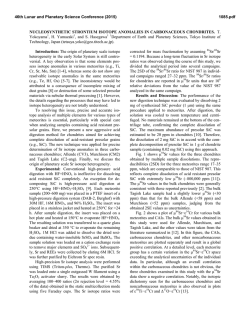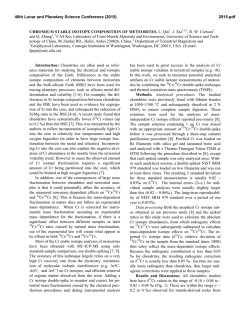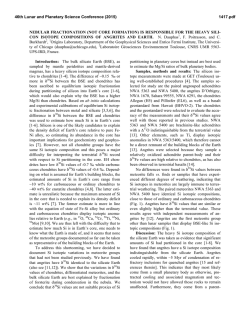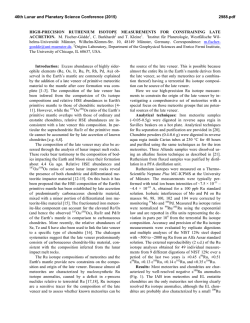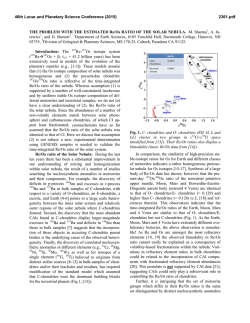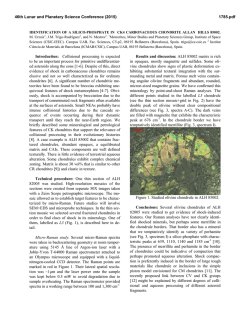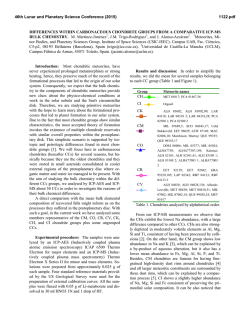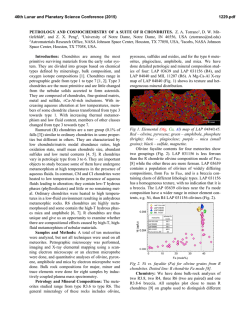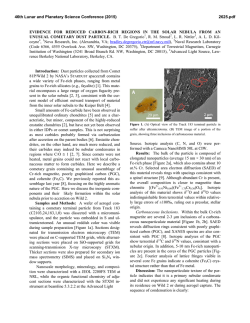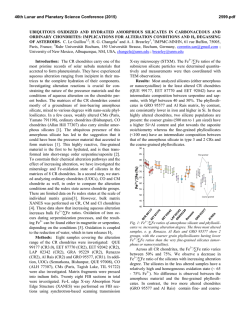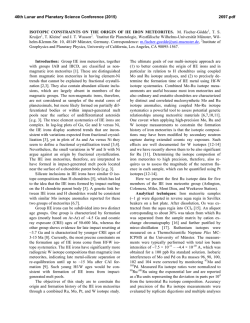
High Precision Neodymium Isotopic Analysis of Chondrites with
46th Lunar and Planetary Science Conference (2015) 1667.pdf HIGH PRECISION NEODYMIUM ISOTOPIC ANALYSIS OF CHONDRITES WITH COMPLETE SAMPLE DIGESTION. R. Fukai1, T. Yokoyama1, S. Kagami1, H. Takahashi1 1Department of Earth and Planetary Sciences, Tokyo Institute of Technology, Japan ([email protected]). Introduction: A variety of isotope anomalies have been discovered in bulk chondrites and differentiated meteorites (e.g., Cr, Sr, Mo [1-3]). These results point to the existence of planetary-scale isotope heterogeneities for refractory heavy elements, which are most likely due to the heterogeneous distribution of presolar grains (e.g., SiC, graphite) in the protosolar nebula before the onset of planetesimal formation. In contrast, some elements exhibit uniform isotope compositions across different meteorite groups (e.g., Te, Os, Hf [46]). Such inconsistencies regarding the isotope distribution are critical to understanding the processes occurred in the solar nebula and/or in planetary bodies. High precision Nd isotope analyses in meteorites have been the center of interest in recent cosmochemistry community [7-10]. One of the most remarkable results is that chondrites possess 142Nd/144Nd ratios ~20 ppm lower than those in terrestrial rocks [7]. The anomaly was interpreted to be caused by the Sm-Nd fractionation via early differentiation of the terrestrial mantle. On the other hand, variations in stable Nd isotopes (e.g., 148,150Nd/144Nd) have been documented in chondrites [9]. Although the authors concluded that the observed variation was due to incomplete digestion of presolar grain-bearing samples, the existence of Nd isotope anomalies in bulk aliquots of chondrites remains unclear unless high precision Nd isotope data with complete sample digestion become available. In this study, we revisit high precision Nd isotope analysis of chondrites coupled with a new sample digestion technique that confirms complete dissolution of acid resistant presolar grains. We also develop a modified dynamic multicollection method using TIMS to improve the analytical reproducibilities. Finally, we discuss the extent of Nd isotopic heterogeneities across different types of chondrites. Experimental: We investigated two carbonaceous chondrites (Murchison, CM2; Allende, CV3), three ordinary chondrites (Chergach, H5; Saratov, L4; St.Severin, LL6), and a Rumuruti chondrite (NWA 4814, R4). The meteorite chips were cleaned with acetone and H2O, then powdered using an agate mortar and pestle. The ordinary and Rumuruti chondrites with a petrologic grade greater than 3 were dissolved by a conventional acid digestion method using HNO3 + HF + HClO4 [11]. For carbonaceous chondrites, each sample was digested using a high-pressure digestion system (DAB-2, Berghof) with HF + HNO3 + H2SO4 to completely dissolve acid resistant presolar grains [12]. After sample digestion, the sample solution was loaded on a cation exchange resin to remove major elements and, for carbonaceous chondrites, SO42− ions, followed by eluting 6M HCl to collect Sr and REEs. From this fraction, Sr was separated from REEs using Sr spec resin (Eichrom) and saved for the study of Sr isotope analysis. Subsequently, Ce was removed from the rest of REEs by passing through the LN resin (Eichrom), during which Ce3+ in the sample solution (10M HNO3) was oxidized into Ce4+ using KBrO3 [13,14]. Finally, Nd was separated from Sm using the LN resin in HCl media. We achieved Ce/Nd = ~3×10-5 and Sm/Nd = ~4×10-5 with >91% Nd recovery. The Nd isotope compositions were measured by TIMS (Triton-plus, Tokyo Tech). Approximately 500 ng Nd dissolved in 1 µL HCl was loaded on a zone refined Re (H. Cross). After dryness, 4 µL 0.01% H3PO4 was loaded onto the sample as an activator. In previous studies, Nd isotope compositions of bulk meteorites have been commonly measured in the “staticmulticollection” mode with TIMS, which may be affected by the time-related deterioration of Faraday cups [15]. In contrast, the “multi-static” [16] or “dynamic-multicollection” methods can reduce the effect of cup deterioration by acquiring Nd isotopes with multiple lines of different cup configurations within a single analytical cycle. In this study, we developed a modified “dynamic-multicollection” method in which 142,148,150 Nd/144Nd ratios were obtained with 2-line cup settings. In addition, we corrected the effect of the time difference between two lines within a cycle. The results were obtained by averaging 360 ratios with 2σ rejection. Results and Discussion: The reproducibilities (2SD) of repeated analyses for a standard (JNdi-1) with the conventional static mode were 4.0 ppm, 11 ppm, and 24 ppm for 142Nd/144Nd, 148Nd/144Nd, and 150 Nd/144Nd ratios, respectively, when the Faraday cups were all fresh. The reproducibilities were getting worse by several times as the deterioration of Faraday cups progressed. In contrast to the static mode, the dynamic method achieved improved reproducibilities; 142 Nd/144Nd: 2.8 ppm (Fig. 1), 148Nd/144Nd: 4.5 ppm, and 150Nd/144Nd: 9.2 ppm. It should be noted that improvements of reproducibilities are evident for 148 Nd/144Nd and 150Nd/144Nd ratios even compared to those obtained in the multi-static method (6 ppm and 19 ppm, respectively) conducted in [16]. Fig. 2 shows the µ142Nd and µ148Nd values in meteorite samples analyzed in this study (the µNd values 46th Lunar and Planetary Science Conference (2015) indicate 106 relative deviation from the isotope ratios of the standard, JNdi-1). Two data points (Allende, St. Severin) were obtained by the dynamic mode, while the rests were obtained by the static mode. All samples have µ142Nd values 20–30 ppm lower than the terrestrial value. In contrast, all but one sample (Allende) have µ148Nd values indistinguishable from the terrestrial value. Likewise, µ150Nd values in chondrites are generally within the range of the terrestrial component. Previous studies [9-10] reported that some chondrites had isotopic anomalies both in µ142Nd and µ148Nd values with a negative correlation in the µ142Nd vs µ148Nd diagram, which can be explained by the mixing of the terrestrial component and the putative sprocess endmember component (Fig. 2). Such a correlation was most likely caused by incomplete digestion of s-process-enriched presolar components (e.g., SiC) present in chondritic samples. As opposed to previous studies, we observed nearly uniform µ142Nd, µ148Nd, and µ150Nd values irrespective of the chondrite group. Although the data points are limited, this study suggests that stable Nd isotopes were homogenously distributed in the protosolar nebula, at least for carbonaceous, ordinary, and Rumuruti chondrites. The small isotopic deviation of Allende could be due to the incorporation of CAIs enriched in the r-process nuclides [9] to the component represented by the other chondrite. As discussed in [10], enstatite chondrites would have elevated µ142Nd values relative to carbonaceous and ordinary chondrites, ranging from -20 to 0 ppm. However, no previous studies performed complete sample digestion for enstatite chondrites, whereas presolar grains reside in type 3 and in even type 4 enstatite chondrites [17]. Therefore, further investigations for the determination of precise Nd isotope compositions by applying the dynamic multicollection method coupled with a complete sample digestion technique should be crucial especially for enstatite chondrites. Fig.1 142Nd/144Nd ratios of repeated analyses for a standard (JNdi-1; n = 12) by the dynamic method. Those obtained by the static mode during the same sample run are shown for comparison. 1667.pdf Fig.2 Plot of µ142Nd and µ148Nd values in chondrites. Error bars of individual data points are 2SE. The gray zones are uncertainties (2SD) of the standard analyzed by the dynamic mode, and dotted lines are those of the static mode when all Faraday cups were fresh. Filled circles indicate the data obtained by the dynamic mode while open circles indicated the static method. Data obtained in previous studies [7-10] are also plotted for comparison. References: [1] Trinquier, A. et al. (2007) ApJ, 655, 1179. [2] Moynier, F. et al. (2012) ApJ, 758, 45. [3] Burkhardt, C. et al. (2011) EPSL, 312, 390. [4] Fehr, M. et al. (2005) GCA 69, 5351. [5] T. Yokoyama, et al. (2010) EPSL 291, 48. [6] Sprung, P. et al. (2010) EPSL 295, 1. [7] Boyet, M. and Carlson, R. (2005) Science, 309, 576. [8] Andreasen, R. and Sharma, M. (2006) Science, 314, 806. [9] Carlson, R. et al. (2007) Science, 316, 1175. [10] Gannoun, A. et al. (2011) PNAS, 108, 7693. [11] T. Yokoyama et al. (1999) Chem Geol. 157, 175. [12] T. Yokoyama et al. (2015) EPSL in revision. [13] H. Tazoe et al. (2007) JAAS, 22, 616. [14] Y. Hirahara et al. (2012) JAMSTEC Rep, 15, 27. [15] Brandon, A. et al. (2009) GCA, 73, 6421. [16] Caro, G. et al. (2006) Geochim, 70, 164. [17] Russell, S. et al. (1997) Meteorit. Planet. Sci. 32, 719.
© Copyright 2025
